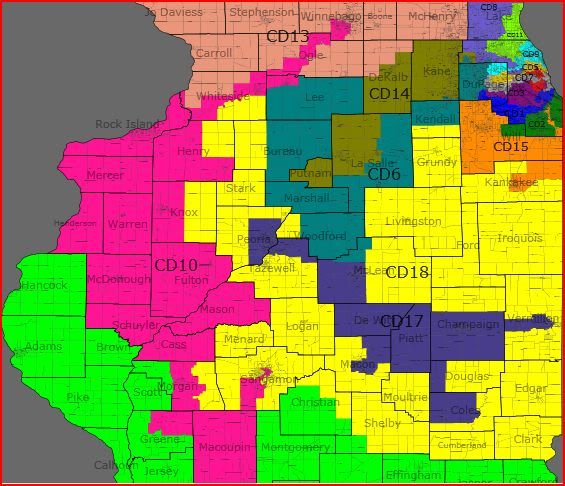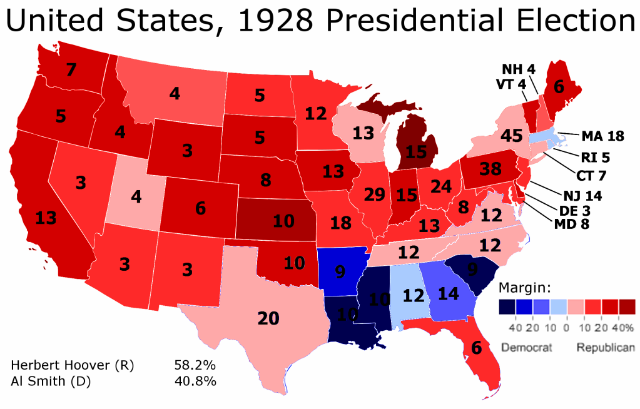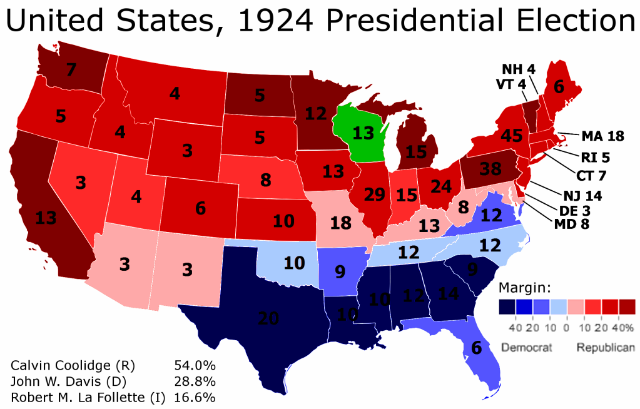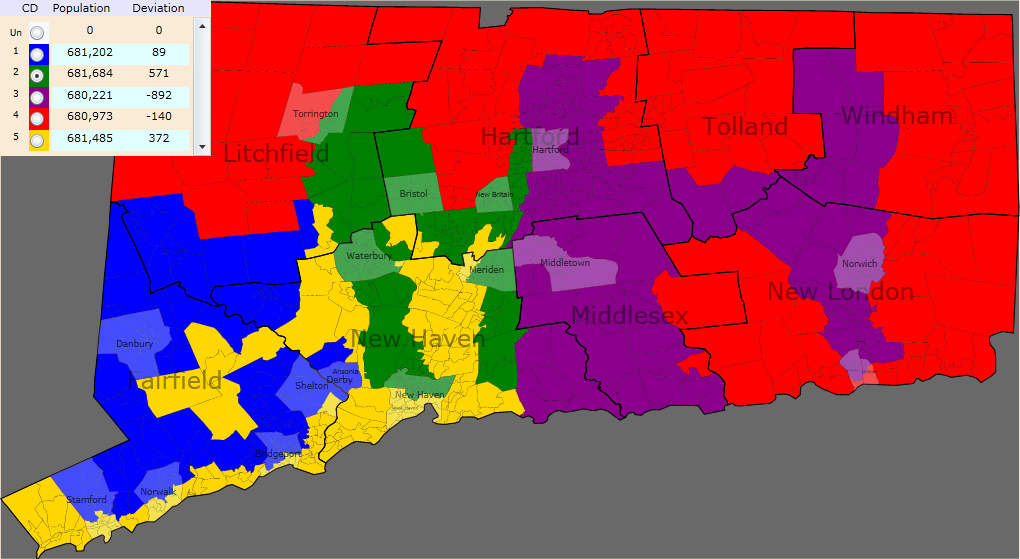With Illinois looking like it’s going to lose a seat, and the Republicans probably having an 11-8 edge in the state’s congressional delegation, assuming Melissa Bean doesn’t close the gap in the 8th District, there’s a lot of room for gerrymandering here. This is my plan.

Greater Chicago
Here’s my rundown by district:
District 1
Incumbent: Bobby Rush
Demographics: 53% Black, 38% White
Summary: This district becomes less African-American and Democratic, largely because the dismantling of Judy Biggert’s 13th district causes the 1st to pick up a chunk of DuPage County. However, it is still overwhelmingly Democratic.
District 2
Incumbent: Jesse Jackson, Jr.
Demographics: 51% Black, 36% White
Summary: This district loses a fair number of African-Americans to the newly-created 15th, which is a Democratic-leaning open seat based in Will County. Like the 1st District, this district is still heavily Democratic and majority African-American.
District 3
Incumbent: Dan Lipinski
Demographics: 63% White, 26% Hispanic, 5% Black
Summary: While this district expands slightly into DuPage county, it picks up a few more Hispanics to make up for the tendril into DuPage. Lipinski has nothing to worry about here.
District 4
Incumbent: Luis Gutierrez
Demographics: 73% Hispanic, 16% White, 8% Black
Summary: I cleaned this district up a bit, getting rid of the earmuffs in favor of a touch point to connect the northern and southern sections of the district. This district is contained entirely within Cook County and is safely Democratic
District 5
Incumbent: Mike Quigley
Demographics: 61% White, 26% Hispanic, 8% Asian
Summary: Like most Chicago districts, it expands slightly into DuPage County, but is still Safe D.
District 6
Incumbents: Peter Roskam, Randy Hultgren
Demographics: 75% White, 12% Hispanic
Summary: This is a Republican vote sink based in western DuPage County and extending into Downstate Illinois. My guess is that Hultgren would run in the neighboring 14th, since this is mostly Roskam’s turf.
District 7
Incumbents: Danny Davis, Judy Biggert
Demographics: 52% Black, 36% White
Summary: Danny Davis’s district extends into DuPage county and takes in Judy Biggert’s home. The district stays majority African-American and safely Democratic. My guess is that Biggert ends up retiring.
District 8
Incumbent: Joe Walsh
Demographics: 73% White, 15% Hispanic, 8% Asian
Summary: This district is designed for a comeback by Melissa Bean, assuming she loses. It drops its portion of McHenry County, and moves further into Cook County. This should be a Democratic-leaning district that ensures that Walsh is a one-termer.
District 9
Incumbent: Jan Schakowsky
Demographics: 61% White, 15% Hispanic, 12% Asian, 8% Black
Summary: Takes in part of DuPage county and switches out some territory with Dold’s seat. This district should be less Democratic, but still not a place where a Republican could be competitive.
District 10
Incumbent: Bobby Schilling
Demographics: 81% White, 9% Black, 7% Hispanic
Summary: The boundaries of this district are tweaked to ensure that Bobby Schilling is a one-termer. The district drops heavily Republican Adams and Hancock counties, and instead picks up a heavily Democratic portion of Rockford. This new district should be somewhere along the lines of 58-59% Obama.
District 11
Incumbent: Robert Dold
Demographics: 65% White, 19% Hispanic, 9% Asian, 5% Black
Summary: Bob Dold thinks Bob Dold should have a second term, but I bet the people drawing the maps in IL will disagree. This district swaps some territory with the adjacent 9th, which makes it even more Democratic.
District 12
Incumbent: Jerry Costello
Demographics: 79% White, 16% Black
Summary: This district, which includes suburbs of St. Louis and parts of Southern Illinois, is gradually drifting away from its Democratic roots. I shored it up a bit by adding a few Democratic areas and subtracting a few Republican ones, but there’s only so much I can do.
District 13
Incumbent: Donald Manzullo
Demographics: 85% White, 9% Hispanic
Summary: Manzullo is one of the big winners here. He loses Democratic areas of Rockford, and picks up sections of McHenry County from the 8th District.
District 14
Incumbent: VACANT
Demographics: 66% White, 25% Hispanic, 5% Black
Summary: This district is based in Kane County and should hopefully be about 56-57% Obama. I removed some of the more Republican areas, and added some heavily Hispanic areas of Cook County. There’s a pretty good chance that Randy Hultgren will move here to run. However, this seat is designed for Bill Foster to make a comeback.
District 15
Incumbent: VACANT
Demographics: 64% White, 16% Black, 15% Hispanic
Summary: This is an open seat based in Will County, with a tendril extending into some heavily Democratic areas of Cook County. Should hopefully be about 58% Obama.
District 16
Incumbent: John Shimkus
Demographics: 94% White
Summary: A downstate vote sink for Shimkus. This district is huge, and even more Republican than Shimkus’ current district, which is pretty damn Republican. Shimkus has this seat as long as he wants it.
District 17
Incumbents: Aaron Schock, Tim Johnson
Demographics: 79% White, 12% Black
Summary: This district is designed to elect a Democrat, likely State Senator Mike Frerichs. It combines the Democratic areas of Aaron Schock and Tim Johnson’s districts, and I would guess it gave Obama about 57% of its votes. It would surprise me if Schock ran here, since the new 18th district, which is heavily Republican and contains most of his territory, is located nearby.
District 18
Incumbents: Adam Kinzinger
Demographics: 92% White
Summary: This is a Republican vote sink and includes Adam Kinzinger’s home and a lot of territory belonging to both Kinzinger and Aaron Schock. Expect a brutal primary here between the two incumbents.
This map should shift the balance of power in the Illinois congressional delegation from 11-8 Republican (assuming Joe Walsh beats Melissa Bean) to 14-4 Democratic, although that depends on the Dem’s ability to knock off Dold in a Democratic seat and retake the 14th district.







